Casing While Drilling
Casing drilling rig selection for Stratton field, Texas
Apache Corp. selected purpose-built casing drilling rig after studies indicated improved drilling performance to recover trapped gas.
Dennis L. Bickford, Apache Corp., and Mark J. Mabile, Drillmar, Inc.
Apache Corp. was investigating new methods to efficiently produce trapped gas in its Stratton field in South Texas. Recent wells drilled conventionally did not achieve desired commercial and operational objectives. Casing drilling (CD) was selected as a method to achieve these objectives through the operational efficiencies it achieves1 and the ability to minimize lost circulation.
Two options were considered during the rig selection phase. The first was to utilize a purpose-built casing drilling rig. The second was to convert a conventional rig to drill with casing. The project also dictated that a retrievable casing drilling system be used to meet logging requirements.2 Specialized equipment to drill with casing and retrieve bottomhole assemblies was required. Key components of the analysis included commercial implications of the rig choice, operational performance, and rig crew experience with casing drilling.
INTRODUCTION
Stratton field, discovered in the late 1930s,3 is a Gulf Coast field located about 45 miles west of Corpus Christi. To date, about 495 wells have been drilled on 20- to 40-acre spacing.
The previous drilling program conducted in 2000/2001 yielded below-average results both commercially and operationally. The below-average performance can be attributed to three main areas. The first area of concern was the amount of drilling fluid lost to the wellbore during drilling and its effect on well production and economics. The second was wellbore stability through the Anahuac shale section. The third concern was a low drilling penetration rate in shales.
A pilot project utilizing casing drilling was selected as a possible solution. CD was selected as a method to drill the wells with minimum losses and, in turn, less risk. The analysis also determined that the wells could be drilled in less time by minimizing time-dependent wellbore stability problems in the Anahuac shale. CD was also selected based on the analysis that the wells could be drilled more efficiently and with equal or greater rates of penetration than with conventional drilling.
A three-well program was conducted to test the CD technology and its ability to lower costs, minimize lost circulation and lower drilling risks. Due to certain requirements of the drilling/ completion program, a retrievable CD system was selected; this required a rig capable of using that system. Rig selection centered on two options: 1) utilization of a rig purpose built for casing drilling, or 2) a conventional rig converted to handle CD with retrievable systems. This article explores the rig selection process and its effect on the drilling program.
REQUIRED CASING DRILLING EQUIPMENT
Critical to the analysis were the actual additional rig components required to drill with casing. The additional components included a top drive, CD assembly, split crown block, split traveling block, wireline winch and wireline BOPs. These items were considered essential to use a retrievable CD system.
The top drive is specifically designed to accommodate wireline BOPs and the CD assembly. The bore through the top drive is larger than normal to facilitate running/ retrieving the wireline rope socket. The top drive is the only practical method to rotate casing during drilling operations.
A casing drive assembly is used to engage and hold the casing during drilling operations, Fig. 1. A cup packer on the bottom of the assembly allows for circulation. The CD assembly comprises an actuator, slips and cup packer. Two CD assemblies were required to drill the well. One allows the grapples to grip the outside diameter of smaller size casing; the other allows the grapples to grip the inside diameter of larger size casing.
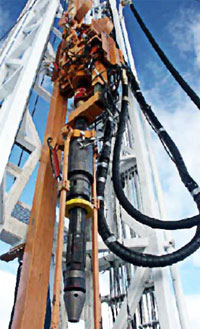 |
Fig. 1. Casing drive assembly.
|
|
Two of the basic necessary components were the split crown block, Fig. 2, and a split traveling block, Fig. 3. Wireline is utilized to retrieve bottomhole assemblies (BHAs). The split blocks allow the wireline to be run through the crown and down through the top drive, and then through the casing drive assembly into the casing. This facilitates circulation while conducting wireline operations.
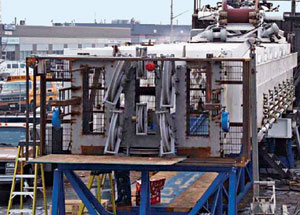 |
Fig. 2. Split crown block.
|
|
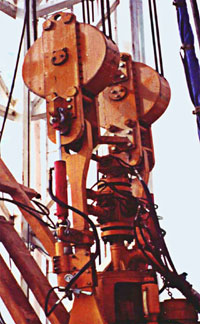 |
Fig. 3. Split traveling blocks and wireline BOP.
|
|
The rigs include a wireline winch used to retrieve the CD BHAs. Controls for the wireline winch are usually operated by the driller and are mounted in the driller’s cabin. The winch must have sufficient capacity to pull the retrievable BHAs while not exceeding their safe working limits.
A wireline BOP is connected to the top of the top drive, Fig. 3. This BOP’s primary purpose is to control the well in the event of a well-control situation during wireline operations. Another purpose of the preventer is to allow the wireline to be run in and out of the hole while circulating.
PURPOSE-BUILT CASING DRILLING RIGS
Presently, three purpose-built casing drilling rigs are available to drill on land with retrievable CD systems. All three rigs were constructed and are owned by the same contractor, Tesco. The rigs are equipped with a variety of features designed for casing drilling. These features enhance the rig’s ability to perform at optimal conditions.
In addition to the above required components for a CD operation, the rigs also include automated catwalks to deliver the casing to the rig floor. Other components include automated slips and elevators to help minimize human interaction while making connections. HSE was a critical component of the analysis and these components provided an additional positive argument for the purpose-built rigs.
The three casing drilling rigs were originally built with two-year contracts in place.4 Due to the efficiencies of casing drilling, the operator was able to drill more wells in a shorter time. As a result, the operator was able to make a rig available for a three-well pilot program, with the intention that it would be returned to the operator to complete the work program. The availability of a purpose-built CD rig to drill Stratton wells presents the team with another option for the program, as described below.
CONVENTIONAL DRILLING RIG CONVERSION
A conventional drilling rig can be converted to drill with casing. The conversion to CD requires addition or replacement of several key components. Conversion costs can vary depending on rig design and layout. Due to differences in conventional rigs and the uncertainty in their availability, an average conversion cost was used for each item in this analysis.
To facilitate the retrievability of the casing drilling BHAs, a wireline winch must be installed along with the winch controls. A wireline BOP must also be installed on top of the top drive.
Addition of a through-bore top drive with necessary connections to accept the wireline BOPs is also required. The top drive enables casing rotation with the casing drive assembly. The top drive installation could also require modifications to the mast.
The crown and traveling blocks must be split to enable the wireline to be run through a sheave in the crown. In addition, the wireline sheave must also be installed in the center of the split crown blocks.
Efficiency of the solids control equipment would dictate whether an upgrade is required. Casing drilling cuttings are usually ground down smaller than conventional drilling cuttings due to the larger diameter of the casing and, hence, smaller annulus area. As these cuttings get smaller, solids content in the drilling fluid increases and an increase in mud weight follows. Controlling mud weight would be a critical component in successfully drilling Stratton field wells due to the low reservoir pressures. Conversion items and associated cost based on an average conversion are shown in Table 1.
| |
TABLE 1. Conventional rig conversion cost |
|
| |
Conversion item |
Estimated cost, $ |
|
| |
|
|
| |
Casing drilling wireline winch |
500,000 |
|
| |
Split crown blocks |
150,000 |
|
| |
Split traveling blocks |
150,000 |
|
| |
Wireline BOPs |
50,000 |
|
| |
Solids control equipment |
85,000 |
|
| |
Modify mast for top drive |
20,000 |
|
| |
Rig dayrate (8 days) |
64,000 |
|
| |
|
|
| |
Total |
$1,019,000 |
|
|
Operational differences. The operational differences between a purpose-built CD rig and a converted conventional drilling rig were also investigated. The first operation examined was a rig move. Purpose-built CD rigs historically take 1-1/2 days to rig down, move and rig up ready to spud the next well. A conventional drilling rig converted to CD would take an average three days to move.
These times are also dependent on the time the rig is released. For the purpose of this analysis, it was assumed that the rig release time had no bearing on the rig move time. The time-sensitive costs were taken into account as per Table 2. Trucking costs were expected to remain constant for both operations, even though a conventional rig requires more loads to move.
| |
TABLE 2. Rental and time-sensitive costs |
|
| |
Operation |
Per well cost, $ |
|
| |
|
|
| |
Rig move days |
36,000 |
|
| |
Top drive rig up |
24,000 |
|
| |
Top drive rental |
25,000 |
|
| |
Location construction |
10,000 |
|
| |
Automated catwalk |
12,000 |
|
| |
Casing drive assembly |
20,000 |
|
| |
|
|
| |
Total |
$127,000 |
|
|
Casing drilling necessitates use of a top drive. For this evaluation, it was assumed that a conventional rig would not be originally equipped with a top drive. Therefore, rig-up and rig-down time and rental charges were taken into account.
Surface location area was also studied. A purpose-built CD rig requires a smaller location, compared to a traditional drilling rig. This can primarily be attributed to lower CD load and pressure requirements. Mud pumps can be downsized due to less frictional pressure losses inside the casing and higher annular velocities at a given pump rate in the wellbore annulus. Hook load requirements are also lower in CD.
A review of wells drilled with casing revealed that no over-pull events occurred during drilling. Based on this data, a lower hook load rating could be used. Casing drilling also precludes use of drill pipe and the storage area it requires on location. A conventional rig is designed for drilling with drill pipe, larger pumps and a higher hook load. This requires a larger location and, by default, a higher cost for location construction.
The purpose-built rig also provides a casing drive assembly as part of the rig package. This equipment would have to be rented with a conventional rig. The time to rig the CD assembly up, or to change it out, would be equal in both operations. An additional item not necessarily required for CD is automated pipe handling capability. The purpose-built rig had the ability to raise a joint of casing from the pipe rack, stab and make it up with no physical crew interaction. This increases efficiencies in pipe handling. An added benefit is the elimination of the human factor to increase operation safety.
Casing drilling experience. One of the intangibles in the rig selection process was rig crew CD experience. It is fairly obvious that crews on a purpose-built rig have CD experience, as the rigs were operating for eight months at the time the rig was needed. Previously, the rig crews worked on conventional drilling rigs. This is in contrast to a conventional rig crew that would have virtually no experience drilling with casing.
The subject of rig crew experience is important and was not overlooked, even though a quantitative value could not be placed on it. While the generic aspects are the same with CD as with conventional drilling, the specifics vary widely. A change in mindset is required to drill with casing as many of the conventional drilling parameters differ. Due to the larger volume of the casing, it takes longer for fluid to reach the bit. This can be two to five times more time in casing sizes of 7-in. and above, compared to drill pipe.
Annular volumes are reduced and, as a result, annular velocities are increased. This means drilled cuttings come to surface in less time. This is also a concern during well control events. Crews trained to handle – and who have experienced – these events, are better equipped to handle them in the future. Solids control equipment must also be monitored more closely for optimum performance. The majority of the casing is larger and weighs more than traditional drill pipe. Handling casing as frequently as drill pipe with the same efficiencies is difficult until the crew is comfortable with handling casing.
Several drilling parameters must also be watched more closely. Differences in pump pressure can be an indication of annulus cuttings density increase. The pump-off values must also be taken into consideration when adding weight to the bit for drilling. Pick-up and slack-off weights also give an indication of hole conditions, but with less of a range of values than with conventional drilling. Attention to torque and its effect downhole must also be monitored closely due to casing connection design. The consensus was that crews familiar with these parameters would perform better on the project.
Predicted learning curve. Optimum performance was expected, but it was also recognized that casing drilling technology was still developing, and it would take the drilling of several wells before expected optimum performance was achieved. A detailed study of offset wells was conducted and a predicted learning curve was developed for expected performance after the pilot project. The predicted learning curve was computed for both a purpose-built CD rig and a converted conventional rig, Fig. 4.
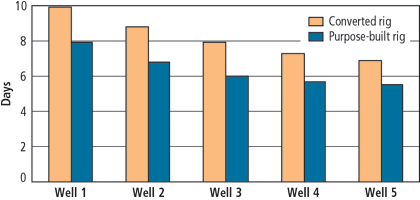 |
Fig. 4. Predicted learning curve.
|
|
The learning curve for the purpose-built rig took into account the experience of the drilling crews with casing drilling. The learning curve for a converted conventional drilling rig crew was not expected to be as good, given the consideration that the crew had virtually no CD experience. The converted conventional rig was also burdened with additional time to rig up the top drive, along with operational inefficiencies, when compared to the purpose-built rig. All auxiliary service costs were expected to remain the same on either rig. Drilling fluid costs could be expected to increase as drilling time increased, but were expected to be minimal in the overall comparison and were not included in the evaluation.
CONCLUSION
The purpose-built casing drilling rig was chosen for the CD program for Stratton field. Operational efficiencies and rig crew experience outweighed the conversion of a conventional drilling rig. This, coupled with the initial conversion cost, would not justify conversion of a conventional rig to casing drilling. Selection of the purpose-built rig as the correct choice is proved by the drilling performance; Fig. 5 shows predicted vs. actual performance.
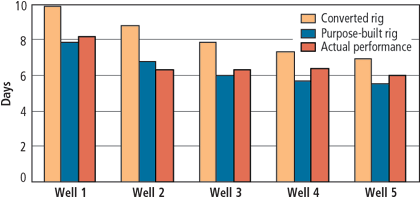 |
Fig. 5. Predicted vs. actual drilling performance.
|
|
Project risk was also less with a purpose-built rig. The rig equipment was previously utilized for casing drilling and the crews had experience with casing drilling. This minimized the risk when compared to a converted conventional rig with new equipment, and crews with no CD experience.
Overall cost to convert, then operate, as a converted conventional drilling rig was higher than utilizing a purpose-built CD rig. And actual performance of the purpose-built rig proves that the correct decision was made, further validating the analysis. 
ACKNOWLEDGMENTS
The authors thank the management of Apache Corp. and Drillmar, Inc. for permission to publish this article. In addition, special thanks go to Tesco Corp. for permission to publish photos of their casing drilling rig and also for their initial guidance in the analysis. The paper from which this article was prepared was presented by the authors at the World Oil 2004 Casing While Drilling Technical Conference, Houston, March 30 – 31, 2004.
LITERATURE CITED
1 Shepard, S., R. Reiley and T. Warren, “Casing drilling: An emerging technology,” Journal of Petroleum Technology, March 2002.
2 Tessari, R. and G. Madell, “Casing Drilling – A revolutionary approach to reducing well costs,” Presented at the SPE/ IADC Drilling Conference, Amsterdam, the Netherlands, March 9 – 11, 1999.
3 Libson, T.F., H.L. Vacca and D.N. Meehan, “Stratton field, Texas Gulf Coast: A successful cased-hole re-evaluation of an oil field to determine remaining reserves and increase production level,” Journal of Petroleum Technology, January 1985, pp. 105 – 124.
4 Fontenot, K., J. Highnote, T. Warren and B. Houtchens, “Casing drilling activity expands in South Texas,” Presented at the SPE/ IADC Drilling Conference, Amsterdam, the Netherlands, February 19-21, 2003.
THE AUTHORS
|
| |
Dennis L. Bickford, drilling superintendent, Apache Corp., graduated from Southeastern Louisiana University with a BS degree. He has 30+ years of oil industry experience in drilling, completion, workover and production operations. Previously, he spent 10 years in Indonesia with Virginia Indonesia/ Roy M. Huffington Co. working in the workover, completion and drilling department. Before that, he was part owner of a company that provided drilling and completion consultants for the oil/gas industry. Mr. Bickford also worked for Mitchell Energy and Shell Oil before going into the consulting business.
|
| |
Mark J. Mabile, VP engineering, Drillmar, Inc., holds a BS degree in petroleum engineering from Louisiana State University and an MS degree in PE from Tulane University. He began his career in production with Conoco and, after three years, transferred to drilling. In 1994, he joined Baker Hughes Solutions as area operations manager for the Far East Business Unit. In 2002, he joined Weatherford as operations manager of multilaterals, and, later, for casing drilling.
|
| |
|
|







